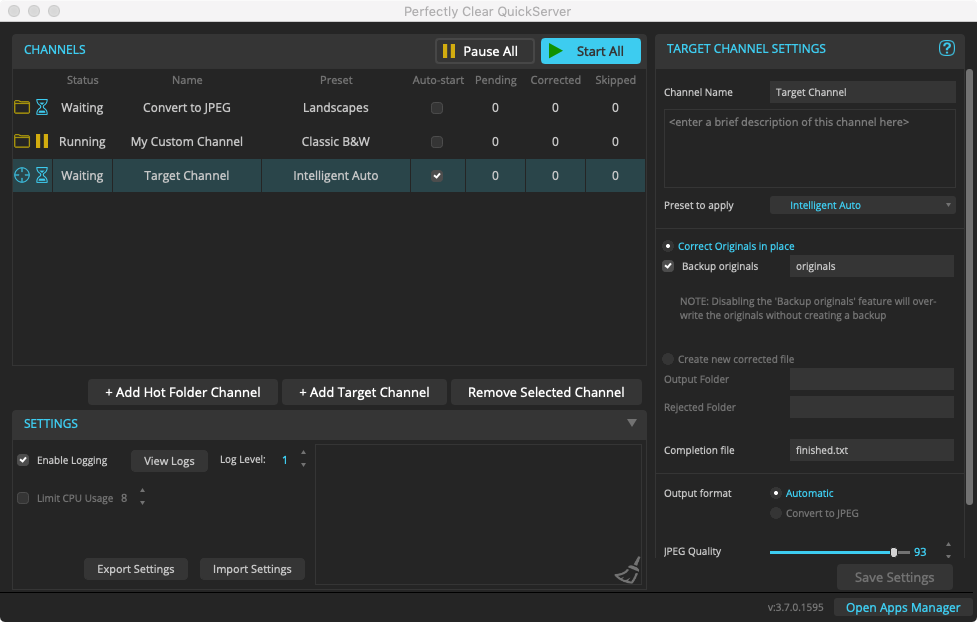QuickDesk and QuickServer are two parts of the same overall product. You can purchase only QuickDesk, or you can purchase QuickDesk and QuickServer....
Read moreHow do Target Channels work?
Target Channels in Perfectly Clear QuickServer allow you to automatically correct images without using the ‘Hot Folder’ approach. This method allows you to correct any image or sets of images that are accessible to your QuickServer computer – either local files or files on a network drive – and it does so without having to move images into an IN hot-folder and then copy them out of the OUT hot-folder.
Here’s a closer look:

In this example, I have one Target Channel, cleverly named “Target Channel”. It is set to “Correct Originals in place” and backup the originals. That means that once the correction happens, the path to the original file will now contain the corrected image, while backing up the original. If you needed to, you could set it to create a new file for the corrected image in a separate folder.
Now, to tell QuickServer which files to actually correct, you’ll call QuickSever from the command-line. The most common way is with a Manifest File that lists the images to correct and the channel to use. The complete command will look like this:
Perfectly Clear QuickServer.exe --cli --manifest \\file-server\image-store\job-00012345.txt
The manifest file would contain this:
manifest_format_version: 2 channel_name: Target Channel job_complete_triggerfile: \\file-server\image-store\job-00012345\done.txt job_images: \\file-server\image-store\job-00012345\images\IMG_0001.jpg \\file-server\image-store\job-00012345\images\IMG_0002.jpg \\file-server\image-store\job-00012345\images\IMG_0003.jpg \\file-server\image-store\job-00012345\images\IMG_0004.jpg \\file-server\image-store\job-00012345\images\IMG_0005.jpg \\file-server\image-store\job-00012345\images\IMG_0006.jpg :end_of_job
This lists every file to correct and which channel to use. The channel defines where to put the output and original files, and what settings to apply. Once the job is complete, you’ll have these corrected images:
\\file-server\image-store\job-00012345\images\IMG_0001.jpg
\\file-server\image-store\job-00012345\images\IMG_0002.jpg
\\file-server\image-store\job-00012345\images\IMG_0003.jpg
\\file-server\image-store\job-00012345\images\IMG_0004.jpg
\\file-server\image-store\job-00012345\images\IMG_0005.jpg
\\file-server\image-store\job-00012345\images\IMG_0006.jpg
and the originals will be here:
\\file-server\image-store\job-00012345\images\originals\IMG_0001.jpg
\\file-server\image-store\job-00012345\images\originals\IMG_0002.jpg
\\file-server\image-store\job-00012345\images\originals\IMG_0003.jpg
\\file-server\image-store\job-00012345\images\originals\IMG_0004.jpg
\\file-server\image-store\job-00012345\images\originals\IMG_0005.jpg
\\file-server\image-store\job-00012345\images\originals\IMG_0006.jpg
And the last step is that QuickServer will write a “completion file” to inform you that the job is finished. This is specified in the manifest file:
\\file-server\image-store\job-00012345\done.txt
You can setup other systems to monitor for this file, knowing that every image in that job was corrected before that file was written.
So, what does this feature really provide?
Quite a bit, really! This allows integration with a huge range of systems and lab management tools. It means that you don’t need to move image files around in order to use our auto-correction capabilities.